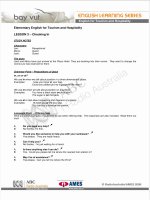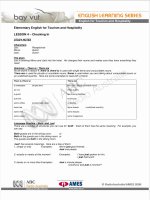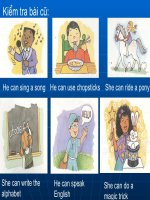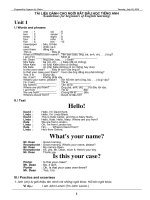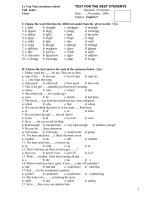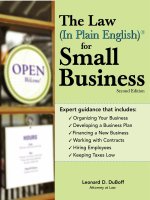English for construction 1-2012
Bạn đang xem bản rút gọn của tài liệu. Xem và tải ngay bản đầy đủ của tài liệu tại đây (21.24 MB, 81 trang )
ALWAYS LEARNING
PEARSON
English
for Construction is part of the Pearson Longman
Vocational
English
series.
It is designed for
students
in vocational
education and for company employees in training at
work.
Written
by
industry
practitioners, it combines a strong grammar syllabus
with
the
specialist vocabulary and
skills
that learners need to
succeed
in their
chosen
field.
Level
1
English
for Construction is designed for
students
with
a
basic
knowledge of general English who now require an elementary (CEF
level
A1-A2)
English
course
in this specific
field.
It includes:
•
topics that reflect the latest developments in construction, making them
immediately
relevant to students'
needs.
•
clearly defined language and
function
objectives
which
are backed up by
comprehensive
on-the-page
language boxes.
•
essential online support for
teachers
including
teacher's
notes,
fully
editable
tests
and
multilingual
glossaries.
•
student
CD-ROM
with
interactive glossaries in both
British
and
American
English and
full
course
book audio in MP3 format.
Other
titles in the series include:
English
for Banking & Finance
English
for
Information
Technology
English
for Nursing
English
for Oil and Gas
.pearsonELT.com/vocationalenglish
^COMMON
EUROPEAN
FRAMEWORK^
A
1
i
n
1
Level 1
A2
Level 1
A2
Level
2
Bl
Level
2
Bl
B2
m
ISBN
978-1-4082-6991-6
78H08"269916
Contents
Function
Language
Vocabulary
industry
Introductions
p. 4
Introducing yourself
and
others Present simple:
be
Present simple: regular verbs
Adverbs
of
frequency
Jobs
-uction
Finding
out
more
p. 6
Talking about jobs
in the
construction industry
Wh-
questions
Questions with
be
The alphabet
Wh-
question words
e
consti
The
construction
industry
p. 8
Describing parts
of
the
construction industry
Plurals
Prepositional verbs
Types
of
construction
Industry sectors
lit
1
Th
Parts
of a
house
p. 10
Understanding
a
house plan
Naming parts
of a
house
77i/sis
House features
Review
p. 11
Trades
and
training
p. 12
Describing trades
and the
stages
of trade training
Present simple
Trades
Vocational courses
(ft
<B
Trade materials
p. 14
Talking about materials
Making calculations
Parts
of
speech
Numbers
1-100
Materials
Calculation words
Unit
2
Trat
Instructions
p. 16
Giving instructions
Saying where things
are
The imperative
Sequencers
Prepositions
of
place
Scaffolding
The
apprentice
p. 18
Giving personal information
Questions
and
answers
for
personal information
Tools
Review
p. 19
c
B
Delivery
p. 20
Answering questions about
delivery
Talking about
the
delivery
of
heavy equipment
Present continuous
Movement verbs
equiprr
Cranes
p. 22
Using cranes
and
control units
Opposites
There
is/There
are
Cranes
it
3 Heavy
Controls
and
equipment
p. 24
Asking questions about
equipment
Explaining
how
to
mix
cement
clockwise/anticlockwise
Remote controls
Equipment
for
mixing concrete
c
3
On site
p. 26
Making conversation Word order
Expressions: fair
enough,
will
do
Question phrases
Review
p. 27
Building materials
p. 28
Talking about building suppliers
and materials
Word pairs
Products
and
materials
supplie:
Materials
p. 30
Placing
and
confirming
an
order
Checking stock items
Phrases:
order
number,
in
stock
Making requests
Supply orders
Unit
4 Building
Insulation
p. 32
Talking about insulation
Changing
a
customer
order/
delivery
Use
to/Used
as/Used
for
Emails
Types
of
insulation
Stock
Unit
4 Building
Problems
on
site
p. 34
Explaining problems
Too/Not
enough
Parts
of a
building site
Adjectives: soft,
wet,
heavy
Review
p. 35
Contents
Function
Language Vocabulary
On-site
subcontractors
p. 36
Describing what subcontractors
do/are doing
at
the moment
Present simple and present
continuous
Subcontractors
s
»
Directions
p. 38
Following directions
Giving directions
Giving directions Maps
Unit
5 On
Weather
on site
p. 40
Understanding different types
of
weather
Giving reasons
Because
of
Weather
Food
p. 42
Talking about food Conversation using present
simple and present continuous
Food
Review
p. 43
Warning
signs
p. 44
Identifying different types
of
signs
Must
Personal protective equipment
(PPE)
and
safety
Site
safety
p. 46
Describing problems
Completing
a
vehicle safety
checklist
Adjectives: too
full
Health and safety
Vehicle parts
5
Health
First
aid
p. 48
Explaining injuries
Past simple:
be
Past simple
Parts
of
the body
A first aid
kit
c
D
Waste
disposal
p. 50
Understanding waste disposal
and colour codes
Word partnerships:
clean
metal,
general
waste
Waste materials
Review
p. 51
factor's office
Clients
p. 52
Welcoming clients
Word pairs Job descriptions
Nouns: structural engineer,
bookkeeper
factor's office
Projects
p. 54
Discussing projects
Describing structures using
dimensions
Metric and imperial
measurements
Buildings
' The cont
Shapes
p. 56
Describing the shape
of
constructions
Expressions: 30
by 60
Shapes
Dimensions
Word stress
Unit;
Calculations
p. 58
Giving calculations
Calculating an area
Calculations
Word order
Calculation symbols
Review
p. 59
•o
i
Planning
a
project
p. 60
Planning
a
new bridge
Completing
a
schedule
Will
future
Calendar
Months
of
the year
8
Planning ahe
Schedules
p. 62
Making appointments
Telling the time
Prepositions
of
time Dates and times
8
Planning ahe
Bridges
p. 64
Making comparisons
Comparative and superlative
adjectives
Descriptive adjectives
Unit
Quantities
p. 66
Writing quantities
How
much/How many Containers
Review
p. 67
Partner files
p. 68
Audio
script
p. 72
1
The
construction
industry
•
introduce yourself
and
others
•
talk about
jobs
in the constructior
industry
•
describe
types
of construction
•
understand a house plan
Introductions
a
building
inspector
a
rooter
Vocabulary
Listening
2
Match
photos A-E to texts 1-5.
1
Hello,
I'm Kamal Boukhaled,
from
Morocco. I'm a plumber.
I'm
Isabelle Roux,
from
France. I'm an architect
Hi,
my
name's
Santiago Cruz. I'm
from
Venezuela. I'm a
crane
operator.
Hi,
I'm
Karol
Nowacki.
I'm
from
Poland. I'm a roofer.
Hello
there. My
name's
Jun Takahashi. I'm
from
Japan.
I'm a
building
inspector.
Complete
these
conversations. Then listen and compare your
answers.
1
Jun:
Isabelle:
Jun:
Isabelle:
2
Karol:
Santiago:
Karol:
Santiago:
Karol:
3 Kamal:
Santiago:
Kamal:
Santiago:
Kamal:
4 Kamal:
Karol:
Kamal:
Isabelle:
Karol:
Kamal:
Karol:
Kamal:
Isabelle:
Hi!
I'm Jun Takahashi,
from
the
Ministry.
Hi,
Mr Takahashi. (1) Isabelle Roux. I'm
from
(2)
I'm
the architect on this project.
Ah,
I'm a
building
(3)
Pleased
to (4) you.
Hi!
Karol
Nowacki.
Santiago Cruz.
What
do you do, Santiago?
I'm
a
crane
(5) And you?
Me? I'm a(n) (6)
Hi!
My
(7) _
.
is Kamal Boukhaled.
Hi,
Kamal. I'm Santiago.
(8)
are you from?
From
Caracas,
Venezuela.
Ah,
Caracas.
A beautiful
city.
I come
from
(9)
Hello.
(10)
Hi,
Kamal. I'm
Karol
Nowacki
name's
Kamal Boukhaled.
And
this is Isabelle Roux.
Hello,
Isabelle.
Pleased
to meet you.
What
do you (11) , Kamal?
I'm
a plumber.
I'm
a roofer. And Isabelle
designs
buildings.
She's
a(n) (12) ?
Yes,
that's
right.
4
1
The construction industry
Reading
3
Read
this text and underline the verbs.
Harun Rashid is 35
vears
old. He
comes
from
Alexandria,
but lives and works in Cairo.
Harun is a general contractor. He hires subcontractors to
work
on
building
projects. He
also
organises
the material
and equipment. Harun has a lot of
experience
in the
construction industry.
Harun always works hard.
Sometimes
he has meetings
with
clients.
Sometimes
he visits construction
sites.
And
sometimes
he
deals
with
suppliers. He is always busy.
But
Friday is different. Harun
never
works on Fridays.
Friday
is a day off.
Correct
these
sentences.
1
Harun Rashid is a plumber.
2 He hires clients to
work
on
building
projects
3 He has a lot of
experience
in the tourist industry.
4 He
never
visits construction
sites
5 He always works on Fridays
Language
Present
simple:
be
We
use be to say who
somebody
is or
what something
is.
I'm Santiago Cruz.
He's
Harun
Rashid.
This
is a
construction
site.
We're roofers.
We
use be to ask
personal questions.
What's
your name?
My
name's Karol.
Present
simple: regular verbs
We
use the
present simple
to
talk about routines,
permanent situations
and
general truths.
We
work
in an
office.
Water
freezes
at 0°C.
We
use
adverbs
of
frequency
and time
expressions
with
the present simple.
Harun
Rashid
never works
on
Fridays.
They
work every Saturday.
Speaking
5
Work
in pairs and introduce yourselves. Use this model to help you.
A
B
Hi!/Hello./Good
morning.
Hi!/Hello./Good
morning.
I'm
/My
name's
.
What's your ?
I'm
/My
name's
.
Pleased
to
meet
you.
Where are you ?
I'm
from And
you?
I'm
from
Finding
out more
Listening
1
flp'
1
'*]ff
Listen
and
repeat
the letters of the alphabet.
Speaking
3
Work
in
pairs. Student
A
look
at the
information
on this
page.
Student
B
look
at
the
information
on
page
68.
Student A
Read the letters to Student
B.
Write
the letters Student B
says.
What do the
letters
mean?
HVAC
rpm AC JCB
HVAC
=
heating,
ventilation
and air
conditioning
rpm
= revolutions per minute
AC
=
alternating current
JCB
=
JC
Bamford
Excavators
Limited
(a construction equipment manufacturer)
4 Practise this conversation
with
your
classmates.
Write
the
names.
A
B
What's your
name?
Jun Takahashi.
How
do you spell that?
My
first
name is Jun -
J-U-N.
My
family
name is Takahashi
•
T-A-K-A-H-A-S-H-I.
Thank
you.
6
1
The construction industry
Listening 5
Listen
to
three conversations. Write
the
jobs
you
hear
for
each person
1
i.
1
Ahmed:
2
Tariq:
3
Jacek:
4
Luis:
Rob:
Pierre:
Kim:
8
Antonio:
Language
Wh- questions
Wh- questions begin
with
a
question word
(e.g.
What, Where,
How).
We use what when we want to know about something.
What's
your name?
What do you do?
We use where to ask about places.
Where
do you
work?
We use how to ask about the way to do something.
How
do you
spell that?
Questions with be
We reverse the order of the verb be to form a question.
He
is on
site
today. •
Is he on
site
today?
6 Read the
three conversations
in
audio script
5 on page 72 and
underline
the
questions
in the
conversations.
7
Complete these sentences
with
What, Where
or How.
- do you
live?
_
do you do?
_ are
you?
_'s your address?
time
is it?
old
are
you?
. is the
site?
. are you
from?
8
Put
the
words
in 1-6 in the
correct order
to
make questions. Then match
the
questions
to
answers
a-f.
1 •
what
/ he
/
do
/
does / ?
2
ncan/you/help/I/?
3 O how
/ spell /
you /
that
/
do
/
?
4
Q
where / work /
you / do
/
?
5 O
what /
you
/
do
/
do
/
?
6 Q are
/
the
/ manager / site /
you
/
?
a) He's a
crane operator.
b) I'm a
plumber.
c) On a
building
site.
d) C-H-E-S-T-E-R-T-O-N-S.
e) I'm
looking
for
Kim.
0
Yes, I am.
Speaking
9
Work
in
pairs. Take
turns
to ask and
answer questions about
the
people
in 5.
A
B
What
does Kim do?
She's
a
site manager.
What about Tariq?
Tariq
is a
OK. Your
turn.
The construction industry 1 7
The construction
industry
Listening 1
Listen
and
write
the
missing letters.
t
n n 1
r
d
br
d
h
s
s h _
1
_ o s p _ t _
1
a.a.tm
t
o_fic_b_o_k
Listen
and
write
the
types
of
construction
you
hear.
4
5
6
Speaking
3 Choose a
role card. Introduce yourself
to
other students.
Use the
model below
to help
you.
Name:
Kasia Katolsky
Job:
building
inspector
Typical projects: factories, schools
From:
Katowice, Poland
Name:
Thomas Smith
Job:
roofer
Typical projects: residential projects (houses,
apartments)
From:
Toronto, Canada
Name:
Mohamed
bin Ali
Job:
site manager
Typical projects: hospitals
From:
Dubai, United Arab Emirates
(UAE)
A
Hi!
I'm
My name's
What
do you do?
What types
of
construction
do
you
work
on?
Where
are you
from?
Name:
Park Ji-Wung
Job:
crane operator
Typical projects: bridges, flyovers
From:
Seoul, Korea
B
Hi!
I'm
Raja Anand./My name's
Raja Anand.
I'm
a
general contractor.
We
build
apartment blocks.
I'm
from Mumbai, India.
8
1 The construction industry
Reading
4
Read
this
text
and
complete charts
A and B.
The construction
industry
in the UK
consists
of
four different sectors.
The
residential
sector deals
with
houses
and
apartments.
The
industrial
sector deals
with
big
projects like factories
and
power
plants.
The
infrastructure sector
is for
projects like roads, bridges
and
tunnels.
The commercial sector
is for
things like
schools, hospitals
and
office blocks.
The
client
pays
for
the project and hires general
contractors
to
deal
with
subcontractors,
equipment
and
materials.
industry
in
the
UK
industrial
(factories,
power plants)
(roads,
bridges,
tunnels)
(schools,
hospitals,
office blocks)
subcontractor subcontractor subcontractor subcontractor
Vocabulary
5
Work
in
pairs. Take
turns
to
draw different types
of
construction
and say
what
they
are.
6
Complete these sentences
with
the
verbs
in the box.
are consists
of
deal
with
hires pays
for
subcontractors.
subcontractors,
equipment
and
materials.
1 The
general contractor
2
General contractors
3 The
team
a
site manager, three roofers
and a
plumber.
4 Roads, bridges
and
tunnels
infrastructure
sector projects.
5 The
client
the
project.
Language
We
add
-s,
-es,
or -/es to
make
a
noun plural.
apartment
-»apartments
box
•
boxes
factory
>
factories
Read
the
text
in 4
again
and
underline
the
plurals.
construction
industry
in
your area. List
Speaking
8
Work
in
groups. Think about
the
examples
of the
following.
1
clients
2
general contractors
3
subcontractors
4 residential sector projects
5
infrastructure
sector projects
6
commercial sector projects
7
industrial
sector projects
The construction industry 1 9
Parts
of a
house
Listening 1 B-'TH Look at house plans A and B. Then listen. Docs the speaker describe
the house correctly?
first floor (American
English) = ground
floor (British English)
bedroom 1
second floor
Speaking
2
Work
in
pairs. Draw
a
simple house plan
and
label it.
Show
it to
your partner
and
ask and
answer questions about it. Then
repeat
with
a new
partner.
A:
What's this?
B:
This
is a
bathroom.
A:
And
this?
B:
This
is the
hrst
floor.
And
this
is the
second
floor.
10
1 The construction industry
Review
Writing 1 Complete
these
sentences
with
information about yourself.
1 My name's
2 I'm an .
3 I live in .
4 I
come
from
2 Match
these
questions to your answers in 1.
a)
Where
are you from?
b) What do you do?
c) What's your
name?
d)
Where
do you
live?
3 Write four things a general contractor
does.
Use the correct form of the
verbs
in
the box.
deal
with
hire organise visit
4 Write four things you do in your job. If you don't work,
choose
a job from
the
unit.
Vocabulary 5 Complete
these
sentences.
The.
The.
The.
The.
The.
. industry consists of four sectors.
. sector
deals
with
houses and apartments.
. sector
deals
with
roads, bridges and tunnels.
. sector
deals
with
schools, hospitals and
office
blocks.
. sector
deals
with
factories and
power
plants.
Write five
examples
of the following.
1 jobs in the construction industry
2 types of construction
3 parts of a house
7 Complete this text
with
the words and phrases in the box.
about a project a new
office
block architect residential area
subcontractor supplier
Today
I
have
three meetings. First, I
have
a meeting (1)
with
a
client
and a(n) (2) in Bulaq. The project is an apartment block in
a(n) (3) . I
have
a lot of
experience
with
apartment blocks, but not
in
this part of Cairo. After
lunch,
I
have
a meeting
with
a new (4)
on
a construction site in Al Nasr
Road.
This meeting is about labourers
and
equipment for (5) . In the evening, I
have
a meeting
with
a(n)
(6) to discuss materials for a construction site in Tura. It's a busy
day as always!
8 What do the following letters
mean?
1
HVAC
2 AC
3 PPE
4 HV
5 kg
6 POL
7 cm
8 rpm
The
construction industry
11
•
describe trades
and the
stages
of
trade train
2
Trades
•
talk
about
trade materials
2
Trades
•
give
and
understand instructions
for
erectin
2
Trades
scaffolding
•
give personal information
Trades
and
training
Vocabulary
1
Label tradespeople
1-8
with
the
words
in the box.
carpenter concrete finisher electrician glazier painter
plumber
roofer welder
ap.
a
c.
a
c
ap.
a
r.
a
w.
ag-
Reading
2 Read
this
text
and
underline
the
trades.
Use the
photos
in 1 to
help
you.
You can refer to
tradespeople in
several ways:
• tradesperson/
tradespeople (for
men and women)
• tradesman/
tradesmen
(for men)
tradeswoman/
tradeswomen (for
women)
A job in the construction industry?
The construction
industry
has
different trades
or
'crafts'.
A
tradesperson
is a
specialist
and
normally
has a
qualification from
a
vocational school
or
other
training
institute.
Plumbers, electricians
and
roofers
are all
tradespeople. Other
tradespeople
on
residential housing projects include carpenters, painters
and
concrete finishers.
Tradespeople
are
often subcontractors
and
work
for a
general contractor
or a
client.
Vocabulary
3
Write
the
plurals
for 1-5.
1 trade
2
craft
3
tradesman
4 housing project
5
general contractor
12
Listening
4
Vocabulary
5
6
Listen
to Sam Smith
talking
about trades and complete these sentences.
Stage 1: apprentice
He/She
is (1) at work.
Stage 2: journeyman
He/She
works (2)
Stage 3: master
He/She
supervises (3) workers.
Listen
again and answer these questions.
1 What is Sam Smith's trade? 2 Where
does
he work?
Look at
this
list
of courses at a vocational school. Match A-C to three of the
courses. Then write the trade
that
each course refers to.
DIPLOMA IN CONSTRUCTION TECHNOLOGIES
1
Basic tools
and
equipment:
2
Carpentry:
3
Masonry
and
concrete:
4
Painting
and
decorating:
5
Electrical
wiring:
6
Residential
plumbing:
7
HVAC:
8
Health
and
safety:
Speaking
7 Work in pairs. Student A look at the information on
this
page.
Student B look at
the
information on
page
68.
Student A
Read
this
email from a vocational school in Calgary, Canada and underline the
key information.
CB2 O •
_
From:
Lucy Dani <>
To: J. Benjamin <>
Thank
you very much for your telephone
call.
Our school offers five apprenticeship
programs which include supervised
training,
on-the-job
training
and classroom teaching.
The programs take three or four years to complete. The programs are HVAC, carpentry,
residential
electrician, welding and masonry. All programs include health and safety
training,
maths and English.
(
8 Work in the same pairs. Compare the two
training
institutes in 7. What things
are the
same?
What things are different?
Trades 2
13
Trade
materials
Vocabulary
1
What materials
do
these
tradespeople
use?
Match materials
A-F to
tradespeople
1-6.
1
carpenter.
2
glazier
3
painter
4 bricklayer
and
mason
5
welder
6
concrete
finisher
Complete
these
sentences.
Write
one
word
in
each
gap.
1
I'm a
bricklayer.
I lay .
2 I'm a(n) I do the
wiring.
3 I'm a(n)
technician.
I do the
heating, ventilation
and air
conditioning.
I'm
a
carpenter.
I
work
with
I'm
a(n) I
install
windows.
I'm
a
painter.
I use _
I'm
a
welder.
I
weld.
to
decorate
houses.
3
Complete
this
table
with
the
missing verbs.
Nouns Verbs
painter
(1)
decorator
(2)
instructor
(3)
welder
(4)
worker
(5)
supervisor
(6)
trainer
(7)
Speaking
4
Work
in
pairs.
Ask
your partner about things
in the
room.
A B
What's that?
^— It's a
window.
What's
it
made
of?
Glass
and
wood.
14
2
Trades
Language
Numbers
1-100
1 one 11
eleven
21
twenty-one
2
two 12
twelve
30
thirty
3
three
13
thirteen
40
forty
4
four
14
fourteen
50
fifty
5
five
15
fifteen
60
sixty
6
six
16
sixteen
70
seventy
7
seven
17
seventeen
80
eighty
8
eight
18
eighteen
90
ninety
9
nine
19
nineteen
100 a
hundred/one hundred
10
ten
20
twenty
Listening
8
+
plus
-
minus
X
times
/
divided
by
=
equals
0
brackets
ciUM Listen
and
tick
/ the
word
you
hear,
thirteen
Q
/
thirty
Q 3
sixteen
Q
/ sixty
[~~|
fourteen
Q
/
forty
Q 4
nine
Q
/
ninety
|
|
Say
these
numbers. Then listen
and
cheek
your answers.
56
13
34
30
89
14
63
40
76
16
21
60
Write
these
numbers.
1
twenty-four
2 thirty-three
3 forty-seven
sixty-nine
seventy-two
ninety-one
rT.'lkJJB
Listen
to an
architect talking about
an
office
block. What
do the
numbers refer
to?
Match
1-5 to a-e.
1
six
a)
number
of
windows
per
floor
2 22
b)
number
of
floors
3
44
c)
m
2
4 32
d)
number
of
rooms
per
floor
5 two
e)
windows
per
room
Make
the
calculations
for the
office
block
in 8.
Example:
1 264 (2
windows
per
room
x 22
rooms
=
44
windows
x 6
floors
= 264
windows)
the total number
of
windows:
264
the total number
of
doors:
the total number
of
rooms:
44
windows;
the total
space per
floor
(m
2
):
Speaking
10
Write
a
number from
1 to 100 on a
piece
of
paper.
On the
other side, write
a
calculation
for the
number.
11
Work
in
small groups.
Read
your calculation
in 10 to the
other students.
The
first
student
to
answer correctly
is the
winner.
A:
Eight times
eight,
plus thirty-one, divided
by
five, plus
thirty-eight equals
B:
Fifty-eight.
A:
Wrong!
C:
Fifty-seven.
A:
Correct!
Trades
2
15
Instructions
Vocabulary 1 Match
diagrams
A-H to the
verbs
in the box.
adjust attach
fill
in fit
join
level
nail
slide
onto
••5
t.
2
Look
at
these
diagrams
of scaffolding and
complete
the
apprentice's
notes.
Then
underline the
verbs
in the
notes.
•
guardrail
ladder
planking
base plate
•
jack
\/ base plate
mudsill
^^"^ nails
r
locking
pin
A-\ 1
coupling
1 P
in
4
J
1
coupling
1 P
in
Erecting scaffolding
Fill in ike holes and level the area. Nail
the (1)
p
|
ates lo ik wuasill!
Sliae the frames Onto the jacks. Adjust
the jacks. Use (Z)
pins flna
locking pins to join the frames. Attach |
braces.
Fit the planking. Attach the guardrails.
Attach the ladder. Inspect the scaffold!
Remember!
Don't climb the scaffolding. Use the
C3)
Don't use bricks to leve
the frames. Use the (4)
Don i forget to use loclom
(5)
Language
The imperative
We can use the imperative to give instructions.
Use don't (do not) before the verb to give negative instructions.
Fill in the
holes.
Don't climb the scaffolding.
We can use the present simple instead of the imperative for
informal instructions.
You level the frames.
Sequencers
We can use
first,
next,
then,
after
that,
etc. to describe the
order of instructions.
First,
fill in the
holes.
Next,
adjust the
jacks.
Then,
fit the planking.
Writing 3 Work in pairs.
Close
your
books.
Write instructions for erecting scaffolding.
16
2
Trades
box
of
pins base plates
hammer
toolbox
jacks
Listening
4
EjuH Look
at the
illustration
above.
Then listen
and
complete
these
sentences.
1 The
base
plates
are the
truck.
2
The
hammer
is the
toolbox,
the
truck.
3
The
coupling pins
and
locking pins
are a
box, the
truck,
the
base
plates.
The jacks
are
the
truck.
The foreman's flask
is .
. the
truck.
Vocabulary
5
Which
sentence
in the
listening
is
incorrect?
Listen again.
Are
these
sentences
true
(T) or
false
(F)?
1
The
base
plates
are
next
to
the
flask.
(T
/
F)
2
The
flask
is
in
the
truck.
(T
/
F)
3
The
jacks
are
behind
the
truck.
(T
/
F)
4
The
hammer
is
under
the
truck.
(T
/
F)
5
The
toolbox
is in
front
of
the
truck.
(T
/
F)
Language
Prepositions
of
place
We
use
prepositions
of
place
to say
where something
is.
(in)
between
The hammer
is
under
the truck. The
toolbox
is in
front
of the truck.
Writing
6
Write four
sentences
to
show
where
the
objects
are in
this illustration.
The apprentice
Listening
1
2i!XEI
Listen to a conversation between a foreman and an apprentice and
complete these sentences about Mickey, the apprentice.
1
Mickey's real name is
2 He
comes
from
3 He lives in .
4 He
goes
to
college.
5 He's a(n)
6 He's years old.
2 lE^^I Listen to an apprentice, Jeff, asking Mickey questions about his
birthday
party and complete
this
information.
1
When:
2 Where:
3 Mickey's telephone number:
Language
3 Match questions 1-7 to answers a-g.
1
How old are you?
a)
Yes, please.
2
What's your name?
b)
It's
265775.
3
Where do you live?
c)
It's
seven
o'clock.
4
Coffee?
d)
I'm
33.
5
What's your telephone number?
e)
It's
John Smith.
6
How
tall
are you?
0
In
Paris.
7
What time is it?
g)
I'm
1.78 m.
4 Complete
this
form
with
information about yourself.
Name:
(1).
Surname:
(2).
Nickname:
(3).
Address:
(4).
Telephone
number:
(5).
Age: (6).
Height
(in cm): (7)
Speaking
5 Work in pairs. Practise
this
conversation.
A:
What's your telephone number?
B:
It's And
yours?
A:
It's
A:
How old are you?
B:
I'm And you?
A:
I'm
A:
Where do you live?
B:
In/At And you?
A:
I live in/at
Review
Writing
1 Write the tradesperson
that
works
with
each of these materials.
1
wood 4 bricks
2 metal 5 concrete
3 glass 6 paint
2 Are these sentences true (T) or
false
(F)?
1
Journeymen work unsupervised. (T / F)
2 HVAC stands for 'heating, ventilation and air conditioning'. (T / F)
3
Twelve
divided by three is three. (T / F)
•
3 Label these diagrams.
4 Write instructions for erecting scaffolding. Use the words in the box.
adjust
attach
fill
in fit inspect
join
level
nail
slide use
SHII^iHHHHHHHHHHHHHHRBBHHilHHHHIHllHHHHHHiHi^
5 Label these diagrams
with
the correct prepositions.
h
r\
&3
6 Complete
this
text
with
the words in the box.
apprentice(s) between on-the-job qualification safety years
The
Institute
of Masonry is in the centre of
town,
in (1) a factory and
an
office block. It has 28 (2) and three
instructors.
All the work is
supervised and includes (3)
training,
instruction
on the use of modern
equipment, tools and materials, and
instruction
on health and (4)
The
training
takes three (5) to complete. At the end of the course,
apprentices get the Level 2 Diploma in Stone Masonry (6) .
Trades 2
19
3
I_J p
\t\t
•
describe
how a
crane
and
«/
•
give instructions
for
oper
6QU1DIT1GII
t
*
talk aDOUt
mixin
g
cement
*• •
make conversation
on
sit<
•
talk
about
the
delivery
of
heavy equipmei
•
describe
how a
crane
and
control units w<
•
give instructions
for
operating equipment
Delivery
Vocabulary
1
Match
sentences
1-4 to
illustrations
A-D.
Then
put
sentences
1-4 in the
correct
order
for
unloading
the
crates.
1
He's
parking
the
truck
on the
hard standing.
|T|
2
He's
unloading
the
crates.
Q
3
He's
adjusting
the
stabiliser.
Q
4 He's
attaching
the
slings
to the
hook.
|
|
Listening 2
EJEH
Listen
to
three conversations about deliveries
and
answer
these questions.
1 What's
in the
crate?
2 What's
in the
box?
3 What's
on the
pallet?
3
Listen
to
three more conversations about deliveries
and
write
(he
problem(s)
with
the
following.
1 rebar
2
timber
3
sand
3
Heavy
equipment
Language
Present continuous
We
use the
present continuous
to
talk about things that
are
happening
now.
We use the
form am/is/are
+ -ing.
I
am
phoning
the
suppliers.
She
is
waiting
for the
timber.
We
are
waiting
for the
driver.
4 Complete these sentences
with
the present continuous form
of
the verbs
in
brackets.
(unload) the
truck.
1
We
2
I
(look for) the site manager.
3
He
(deliver) the sand.
4
She
(phone) the supplier.
5 They
(have)
a
meeting.
6 I'm sorry, but
I
(run) late.
Vocabulary
5 A
crane driver
is
describing
to
an apprentice how
to
operate
a
crane. Look
at
A-C and complete
this
text.
There are two levers. First, the lever on the left. Push it
away from you to (1) the
load.
Pull it towards
you to (2) it. OK?
Second,
the lever on the right.
This moves the load (3) or right. To move the
load to the left, pull it (4) you. To move the load
to the right, push it (5) from you.
Any questions?
6
Answer the apprentice's questions.
1
How
do I
raise the load?
2 How
do I
lower the load?
3 How
do I
move the load
to
the left?
4 How
do I
move the load
to
the right?
5 How
do I
raise the load and move
it to
the right?
6 How
do I
lower the load and move it
to
the left?
Speaking
7
Work in pairs. Imagine you have two crane levers. Take
turns
to
move them.
Your partner says what you're doing
with
the load.
Heavy equipment
3
A: What are the differences between the two
cranes?
B:
The crane on the left is a tower crane. The operator sits in a(n)
(1) near the top of the (2)
There's
a counterweight
behind
the cab. The load is on the other side of the
jib.
The operator
uses
the
winch and block to lower or raise the (3)
A: I see.
B:
The crane on the
right
is a mobile crane. The operator's cab is near the
ground.
The operator extends or retracts the (4) , or
moves
it from
left
to
right
or up and down. Both cranes use stabilisers or (5) ' '
and
counterweights to
maintain
stability.
A: OK. Thank you.
Write
the opposites.
1
extend
2 lower
3 left
Match
1-5 to a-e to make expressions about cranes.
1
operator's a) crane
2 extend b) cab
3 mobile c) the boom
4 raise d) the load
5 tower e) crane
Work
in pairs.
Close
your books. Student A draw a tower crane for Student B
to
label. Student B draw a mobile crane for Student A to label. Check each
other's
work.
22
3
Heavy
equipment
Listening
5
Listen
to a
description
of
crane
controls and
look
at A
and B.
Then
complete
this
text.
•
extend the boom
hook
winch
wind the
winch
cab
Crane operators use different
controls
to
raise and lower the
(1)
,
rotate the cab,
extend and retract the boom, wind
and unwind the
(2)
and control other equipment.
This operator has two
(3)
One controls
left-to-right movement
of
the boom
and the other controls forward
and backward movement.
The operator uses the foot
(4)
to
retract
or
extend the boom.
6
Listen
again
and
check
your
answers
to 5.
Language
There is/There
are
joystick
foot pedal
We use there is/there
are to
say that somebody
or
something exists.
There
is a
key switch
on the
right.
There
are two
joysticks.
Singular questions: Is there
a
stan button? Yes, there
is./No,
there
isn't.
Plural questions: Are there
any
buttons? Yes, there
are./No,
there
aren't.
Negative forms:
There isn't
a
light,
(singular)
There aren't
any
switches, (plural)
Reading
7
Read
this
text about
a
remote
control and label the
illustration.
Sometimes crane operators use remote
controls. In this model there's a stop button
on the left. There's a key switch on the
right. There are two joysticks in the middle.
There are three toggle switches on the top.
'*""'"
"
—
'
Writing
8
Rewrite
the text in
7 for
this
remote
control.
Speaking
9
Work
in pairs. Draw
a
remote
control. Put the controls
where
you
like.
Describe
it
for
your partner
to
draw.
Heavy
equipment
3
23
Controls and equipment
Listening
1
Match
questions 1-6 to answers a-f. Then listen and check
your
answers.
a) Lower it? You
move
the joystick.
b) It's a remote control. That's
right.
c) Yes, that's the power switch.
d) Extend it? You use the pedal.
e) It's for extending the boom.
f) It starts the motor.
1
What's this? A remote control?
2 What's
this
for?
3 What
does
this
do?
4 How do I extend the boom?
5 How do I lower the boom?
6 What's
this
switch for? Is it
the
power switch?
2
K^EQI Put each conversation in the correct order. Then listen and check
your
answers.
1 [T] Did you say
turn
the key?
I
|
Thanks.
• Yes, that's
right.
I
|
Clockwise.
I
|
Clockwise or anticlockwise?
2
|T|
What do I do next?
I
|
Thank you.
• OK. Which one is the start button?
I
|
Press
the start
button.
I
|
It's the green one, on the left.
3 Q] How do I start the engine?
I
|
Switch off?
Press
the big red
button
here.
I
|
Press
the green
button
and
turn
the key.
I
|
Thanks.
I
|
And how do I stop it?
Speaking
3 Work in pairs. Student A look at
illustration
A on
this
page.
Student B look at
illustration
B on
page
68. Write down what each control is for. Then take
turns
to
explain your
illustration.
Use these questions to help you.
What's
this
for?
What does
this
do?
What's
this
switch/button/joystick for?
How do I ?
24
3
Heavy equipment
